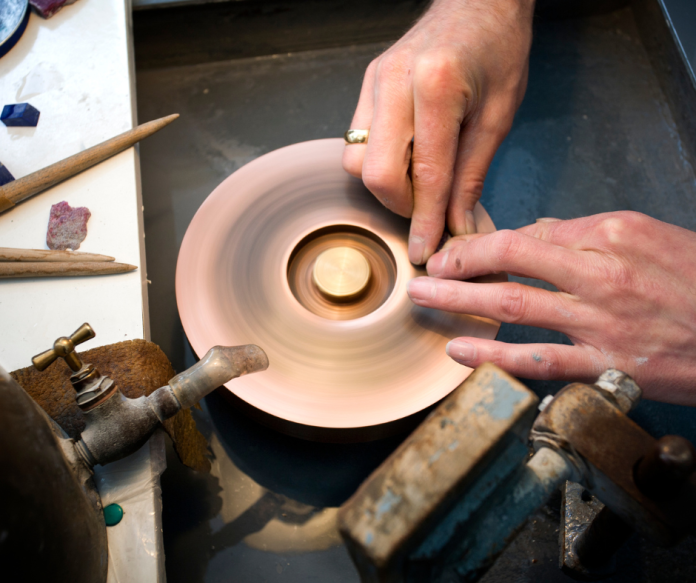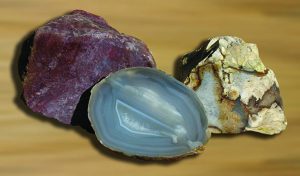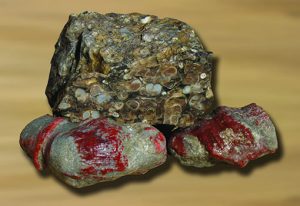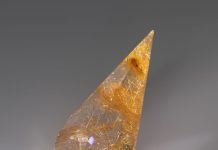
How to handle lapidary materials safely is important when you’re cutting, grinding and polishing rocks and minerals. Here’s what’s dangerous and how to be safe handling it.
After 30 years of procrastination, I purchased a brand-new rock saw and grinder/polisher. Wow, did I have fun! For that first few months of cutting and grinding, I was in seventh heaven. All those lovely rocks I had lusted after for so long were finally put under my polishing wheel: lapis, agate, jasper, tiger’s eye, malachite, turquoise, chrysocolla and quartz.
But I soon began to experience a nasty and completely unexpected cavalcade of health problems: coughing, hoarseness, difficulty clearing my throat, breathlessness, and a dull ache in the pit of my lungs. Of course, I had always worn safety glasses with side protection, as recommended in every manual, but a mask seemed a cumbersome hindrance. As the situation worsened, I tried several dust masks, but there was little improvement. It was time to do a little research, so I hit the books and started talking to fellow rockhounds. It was a revelation. Rock dust from lapidary work turns out to be more than just a nuisance; it can be deadly.
Dangerous Dust
A single heavy dose can cause crippling lifelong problems. It attacks the lungs in a variety of ways: First, by coating the inner lining and blocking the transmission of oxygen into the bloodstream. Second, tiny sharp fragments slice and cut into the alveoli, which coat the inner lining of the lungs, causing irritation and inflammation. Fresh dust seems to be more harmful because the sharp edges have not had a chance to be softened by moisture. Some forms of rock dust are quite poisonous in and of themselves. Whether it is inhaled, ingested, or contacted by exposed skin, the effect can be injurious to your health.
Copper Oxide Minerals

Among the worst offenders are minerals containing copper (II) oxide (CuO), the higher oxide of copper, which can cause damage to the endocrine and central nervous systems. These minerals include some of our most colorful and treasured semiprecious stones: turquoise (9.8% copper oxide), chrysocolla (45%), and malachite and azurite (70%). These percentages are only close approximations; each rock has its own signature of impurities.
It is worth remembering that other closely related copper compounds are highly bioactive and have been used in pesticides, fungicides, and wood preservatives for decades. This is dangerous material. These high-copper rocks should not be licked to bring out the color, and oil mixed with the dust should be carefully cleaned off exposed skin.
Several lapidaries who smoke have described their own novel test for overexposure: Apparently, copper-impregnated dust combines with nicotine and tobacco tar in saliva to form a sickeningly sweet compound similar to saccharin. When their mouths start to taste like a candy factory, these rockhounds know it’s time to quit. Another sign is influenza-type symptoms. Symptoms of CuO dust poisoning mimic the flu, causing headaches, coughing, sweating, sore throat, nausea and fever. Skin, eye, and respiratory tract irritation are also common, along with a distinct “metallic” taste. A common name for these health effects is “metal fume fever.”
Silicate Minerals
Almost all the rocks most favored by cutters and polishers contain compounds that can be dangerous when inhaled. Silicates are the most common family of minerals on Earth, and silicosis has long been one of the chief hazards facing stonemasons.
The ancient Greeks and Romans were the first to observe its ravages and correctly associated the problem with mining and rockwork. Similar to the “black lung disease” of coal miners, it came to be known in later years as “grinder’s consumption.” The simple steps taken to prevent it were a major achievement in the modern field of occupational health. Ironically, although silicosis is well understood today, thousands still die from its effects every year, mainly from mining and sandblasting in the third world.
The symptoms of inhaling crystalline silica (SiO) dust include shortness of breath, cough, fever, emphysema, pulmonary fibrosis, lung scarring, and increased susceptibility to tuberculosis and cancer. Silicosis often takes many years to develop from repeated exposure to low doses of dust, but once established it is irreversible.

Widespread Silicates
The silicates include a bewildering variety of precious and semiprecious stones. In fact, it’s hard to imagine the world without them, as they can be found in every class of rock and occupy a niche in every conceivable geological environment on the planet.
The family includes quartz, chalcedony, jasper, agate, aventurine, bloodstone, carnelian, chrysoprase, amethyst, opal, onyx, beryl, petrified wood, obsidian, flint, chert, soapstone, sandstone, glass and tiger’s eye. In almost all of these, the content of silicon dioxide approaches or exceeds 50%.
It should be mentioned that African tiger’s eye also exposes the lapidary to another potent danger: asbestos. The vibrant optical effect of its chatoyancy is caused by parallel-oriented, finely fibrous amphibole asbestos. Serpentine has a high chrysotile asbestos content, but this is not considered quite as dangerous as the tiger’s eye. Some soapstone varieties also contain asbestos and should be cut or carved with caution.
Fossil Dangers
Radioactivity from fossils is a hazard that isn’t often top of mind. In a recent study of 300 randomly selected fossils from the Hagerman Fossil Beds of Idaho conducted by C. Neal Farmer, Ronald L. Kathren, and Craig Christensen, a handheld Geiger-Müller survey instrument detected discernible levels of radiation one to two orders of magnitude above the ambient level of background radiation in three-quarters of the specimens (“Radioactivity in Fossils at the Hagerman Fossil Beds National Monument”, Journal of Environmental Radioactivity, Vol. 99, Issue #8, August 2008, pp. 1355-1359). That is a huge difference.
In some areas, like the Hagerman Fossil Beds National Monument (Idaho) and the Morrison Formation at Dinosaur National Park (Colorado/Utah), fossils have even been hunted using Geiger counters.
According to the study, radioactive fossils seem to occur most commonly between 900 and 1,000 meters above sea level in ancient sandy riverbeds, while clay-rich deposits and those at other altitudes do not seem to show these high levels. Apparently, naturally occurring uranium produces radium, which decays into radon, an inert gas. Ancient groundwater transported these radioactive elements into sandy fossil-bearing areas, where they precipitated out of solution during the fossilization process. Even small fossils like shark teeth and trilobites can have significant readings.
The National Park Service is so concerned that it put out a “Conserve O Gram” with detailed instructions for handling and displaying specimens. While it is probably safe to collect most fossils, at the very least, you should wash up and change your clothes after leaving the field. And always wear a respirator when you cut or polish the pieces—radioactive dust is highly carcinogenic!
Tips for Safe Handling
But enough of the doom and gloom. A few simple precautions can almost completely eliminate the threat of injury from most rock dusts. Here is a list of suggestions that will make your workshop a lot safer and allow you to enjoy lapidary work in good health.
1. Wear a Mask
Always wear a National Institute for Occupational Safety and Health (NIOSH) approved respirator with replaceable cartridges and dust filters. Some cartridges today combine a prefilter with the cartridge, which makes things simpler.
Respirators provide a wide variety of protection against dusts, solvents, fumes and mists. They are designated N, R and P, depending on the cartridge’s ability to filter out oil; N stands for “no protection”, R for “resistant to oil”, and P for “oil-proof”. The number that follows the initial tells you what percentage of the particulates is filtered out by the cloth prefilter. For example, an N-95 respirator will not keep out oil spray but will screen out 95% of airborne dust particles.
Avoid cheap dust masks; they don’t fit tightly enough and they filter poorly. If you can, try on several different respirators at the store to get the best fit. Shave your beard, if you have one, to get an airtight seal. Store the mask in a closed container or plastic bag when it’s not in use, and occasionally wash it with warm soap and water, both inside and out.
Try this simple negative pressure test on your respirator: Block up the air inlets, breathe in, and hold your breath for 20 seconds. If the mask is still held airtight against your face, it fits. Cartridges should be changed after about eight hours of use.
2. Work Outside and/or Ventilate
An open window or air conditioner does not provide adequate ventilation for the lapidary workplace. The simplest solution is to work outside. This keeps most contaminants out of your workshop and costs nothing, but it is not always possible.
If inside is your preference, consider setting up a local exhaust ventilation system. This would include a dust hood to collect contaminants, ducts to carry them outside, and a suction fan to power the system. Adjustable blast gates would allow a dust hood to be placed next to each appliance. Ducts should be circular, with as few bends as possible, and should exit the shop. If you have close neighbors or are processing a lot of rock, provide a dust collector to remove contaminants from the vented air.
Setting up such an elaborate system can be expensive and time-consuming for the part-time hobbyist. Some woodworking tool suppliers have come up with an ingenious alternative. They have adapted a wet/dry-type vacuum cleaner with a High-Efficiency Particulate Absorbing or Arresting (HEPA) filter to collect shop dust using a little extra pipe and some suction nozzles. There is no reason this system should not work for rock dust, as well. The vacuum should be placed outside the house because the dust-laden air sucked into the intake will be blown out the vacuum’s exhaust port. Even HEPA filters fail or become clogged, and some dust will always slip through. It’s far better for it to be blasted outside than into the shop or another enclosed area. Kits, diagrams, pipe and suction nozzles are available on the internet. Search for “dust collection” and “dust collection network”.

3. Lubricate
Always use water or oil as a lubricant when cutting, drilling, polishing or faceting, but be aware there are problems with both fluids. When water evaporates, it stops holding the dust down, allowing it to become airborne. A fine oil mist laden with toxic dust can be kept out your lungs with a good respirator, but it will settle on skin surfaces and stick like glue. Also, most lapidary oils are highly irritating or downright poisonous to breathe. Some, like old-fashioned kerosene, are dangerously flammable, as well. Everyone has their favorite method, but I work outside using mineral oil and a P (oil-proof) respirator cartridge with a built-in 100% particulate filter.
4. Cover Up
Always wear a head covering and apron and/or coveralls when grinding, and change clothes after you have finished. Rock dust loves to stick to clothing and hair, and you will carry it around the house and breathe it all day long (as will your family) if you don’t change. Take a shower after your lapidary work, shampoo your hair and use lots of soap. Launder coveralls and work clothes frequently. Disposable clothing, coveralls, and an apron might also be an option.
5. Don’t Sweep
Never dry sweep the workshop. Most of the dust will just become airborne and migrate elsewhere. Use a vacuum cleaner with a HEPA filter instead. If you really want to get down and dirty, use a wet mop on the floor and a wet rag with a water bucket on other surfaces.
Not all of these suggestions need to be slavishly followed. If you grind infrequently, you can probably forget some of them, but if you are an addict like me, you might want to implement most. Individuals vary greatly in their tolerance to rock dust. Some will go through life with nary a problem, but others can be extremely sensitive. Low doses on a daily basis will slowly accumulate, and that dust isn’t going anywhere once you breathe it in. Smoking and living with a woodstove or in an area with poor air quality will make you that much more vulnerable to problems. Listen to your body. If your lungs start to complain, take more precautions; you only have one set to last a lifetime.
FURTHER READING: Health Hazards Manual for Artists, 6th Ed., by Michael McCann Ph.D. and Angela Babin (Lyons & Burford Publishers, 2008)
This story about how to handle lapidary minerals safely previously appeared in Rock & Gem magazine. Click here to subscribe. Story and photos by Douglas Hamilton.















